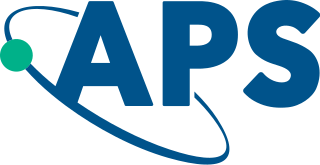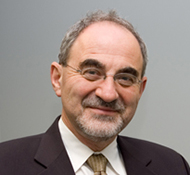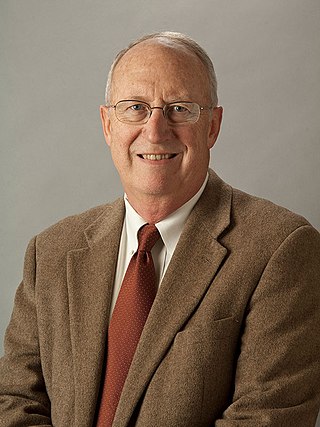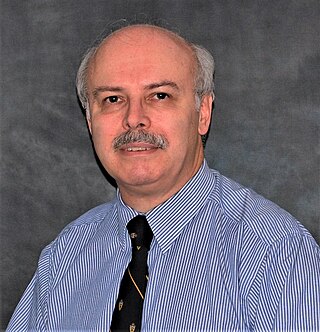Related Research Articles

The American Physical Society (APS) is a not-for-profit membership organization of professionals in physics and related disciplines, comprising nearly fifty divisions, sections, and other units. Its mission is the advancement and diffusion of knowledge of physics. The society publishes more than a dozen scientific journals, including the prestigious Physical Review and Physical Review Letters, and organizes more than twenty science meetings each year. APS is a member society of the American Institute of Physics. Since January 2021 the organization has been led by chief executive officer Jonathan Bagger.

Nick Holonyak Jr. was an American engineer and educator. He is noted particularly for his 1962 invention and first demonstration of a semiconductor laser diode that emitted visible light. This device was the forerunner of the first generation of commercial light-emitting diodes (LEDs). He was then working at a General Electric research laboratory near Syracuse, New York. He left General Electric in 1963 and returned to his alma mater, the University of Illinois at Urbana-Champaign, where he later became John Bardeen Endowed Chair in Electrical and Computer Engineering and Physics.

Eli Yablonovitch is an American physicist and engineer who, along with Sajeev John, founded the field of photonic crystals in 1987. He and his team were the first to create a 3-dimensional structure that exhibited a full photonic bandgap, which has been named Yablonovite. In addition to pioneering photonic crystals, he was the first to recognize that a strained quantum-well laser has a significantly reduced threshold current compared to its unstrained counterpart. This is now employed in the majority of semiconductor lasers fabricated throughout the world. His seminal paper reporting inhibited spontaneous emission in photonic crystals is among the most highly cited papers in physics and engineering.

Gérard Albert Mourou is a French scientist and pioneer in the field of electrical engineering and lasers. He was awarded a Nobel Prize in Physics in 2018, along with Donna Strickland, for the invention of chirped pulse amplification, a technique later used to create ultrashort-pulse, very high-intensity (petawatt) laser pulses.
Margaret Mary Murnane NAS AAA&S is an Irish physicist, who served as a distinguished professor of Physics at the University of Colorado at Boulder, having moved there in 1999, with past positions at the University of Michigan and Washington State University. She is currently Director of the STROBE NSF Science and Technology Center and is among the foremost active researchers in laser science and technology. Her interests and research contributions span topics including atomic, molecular, and optical physics, nanoscience, laser technology, materials and chemical dynamics, plasma physics, and imaging science. Her work has earned her multiple awards including the MacArthur Fellowship award in 2000, the Frederic Ives Medal/Quinn Prize in 2017, the highest award of The Optical Society, and the 2021 Benjamin Franklin Medal in Physics.

Robert Louis Byer is a physicist. He was president of the Optical Society of America in 1994 and of the American Physical Society in 2012.

Cherry A. Murray is an American academic who is professor of physics and the director of the Biosphere2 Institute at the University of Arizona at Tucson. She is the Benjamin Peirce Professor of Technology and Public Policy emerita at, and former dean of, the Harvard School of Engineering and Applied Sciences (SEAS).
Multiangle light scattering (MALS) describes a technique for measuring the light scattered by a sample into a plurality of angles. It is used for determining both the absolute molar mass and the average size of molecules in solution, by detecting how they scatter light. A collimated beam from a laser source is most often used, in which case the technique can be referred to as multiangle laser light scattering (MALLS). The insertion of the word laser was intended to reassure those used to making light scattering measurements with conventional light sources, such as Hg-arc lamps that low-angle measurements could now be made. Until the advent of lasers and their associated fine beams of narrow width, the width of conventional light beams used to make such measurements prevented data collection at smaller scattering angles. In recent years, since all commercial light scattering instrumentation use laser sources, this need to mention the light source has been dropped and the term MALS is used throughout.

Whispering-gallery waves, or whispering-gallery modes, are a type of wave that can travel around a concave surface. Originally discovered for sound waves in the whispering gallery of St Paul's Cathedral, they can exist for light and for other waves, with important applications in nondestructive testing, lasing, cooling and sensing, as well as in astronomy.

John Arthur Woollam is an American educator, research physicist, electrical engineer, and George Holmes Distinguished Professor at the University of Nebraska–Lincoln in Lincoln, Nebraska. He is also a successful entrepreneur who in 1987 founded the J.A. Woollam Company, an ellipsometry company based in Lincoln, Nebraska, and a world leader in the research, development, and commercialization of ellipsometry instruments. Woollam is also a known as a philanthropist and nature conservationist.

Andreas Mandelis is a professor and researcher at the department of Mechanical and Industrial Engineering at the University of Toronto and director of the Center for Advanced Diffusion-Wave and Photoacoustic Technologies (CADIPT). He is an internationally recognized expert in thermophotonics. His research encompasses the non-destructive evaluation of materials with industrial and biomedical applications. He is considered a pioneer in the fields of diffusion-wave, photothermal and photoacoustic sciences and related technologies. He is the inventor of a photothermal imaging radar which can detect tooth decay at an early stage.
Richard Magee Osgood Jr. was an American applied and pure physicist. He was Higgins Professor of Electrical Engineering and Applied Physics at Columbia University.
Miklos Porkolab (born March 24, 1939) is a Hungarian-American physicist specializing in plasma physics.
Wyatt Technology Corporation, or Wyatt Technology, is a developer and manufacturer of instrumentation for the characterization of nanoparticles and macromolecules. Headquartered in Santa Barbara, California, Wyatt Technology was founded in 1981 and incorporated in 1984. Wyatt Technology has developed and introduced instrumentation for the measurement of multiangle light scattering (MALS), quasi-elastic light scattering (QELS), differential refractive index, electrophoresis, viscosity, and composition gradient multiangle light scattering (CG-MALS) for the determination of absolute molecular weights, sizes of nanoparticles, proteins, and polymers within a solution. It was acquired by Waters Corporation in 2023.

Sekazi Kauze Mtingwa: is an American theoretical high-energy physicist. He is a co-recipient of the 2017 Robert R. Wilson Prize for Achievement in the Physics of Particle Accelerators. He is the first African-American to be awarded the prize. Mtingwa was elected a Fellow of the American Physical Society (APS) in 2008 for "his definitive treatment of Intrabeam scattering, his contributions to the wakefield acceleration, and his early recognition of the fixed target physics potential of the next generation electron-positron collider." He also co-founded the National Society of Black Physicists in 1977 and served in various other national and international initiatives.

Dean Lee is an American nuclear theorist, researcher and educator. He is a professor of physics at the Facility for Rare Isotope Beams (FRIB) and the Department of Physics and Astronomy at Michigan State University and department head of Theoretical Nuclear Science at FRIB.
Integrable algorithms are numerical algorithms that rely on basic ideas from the mathematical theory of integrable systems.

Hui Cao (曹蕙) is a Chinese American physicist who is the professor of applied physics, a professor of physics and a professor of electrical engineering at Yale University. Her research interests are mesoscopic physics, complex photonic materials and devices, with a focus on non-conventional lasers and their unique applications. She is an elected member of the US National Academy of Sciences and of the American Academy of Arts and Sciences.
Irving Philip Herman is an American physicist and the Edwin Howard Armstrong Professor of Applied Physics at Columbia University. He is an elected Fellow of the American Physical Society and of Optica, the former for "distinguished accomplishments in laser physics, notably the development and application of laser techniques to probe and control materials processing".
James Benjamin Rosenzweig is a experimental plasma physicist and a distinguished professor at the University of California, Los Angeles (UCLA). In the field of plasma wakefield acceleration, he is regarded as the father of the non-linear "blowout" interaction regime, where a laser beam, when fired into a plasma at intense levels, expels electrons from the plasma and creates a spherical structure that can effectively focus and accelerate the plasma.
References
- 1 2 3 4 5 6 7 8 9 Tretkoff, Ernie (2008). "APS Awards First Industrial Physics Prize to Philip J. Wyatt". APS News. 11. Retrieved July 26, 2016.
- 1 2 3 4 5 6 7 8 9 "Forum on Industrial & Applied Physics". APS Physicsa. Retrieved August 26, 2016.
- 1 2 "SBCC Foundation Board of Directors Philip J. Wyatt, PhD". SBCC Foundation. April 19, 2016.
- 1 2 3 "Commercializing Multi-Angle Light Scattering Instruments - An Interview with Philip Wyatt". AZO Materials. May 20, 2016. Retrieved August 26, 2016.
- 1 2 3 4 Reisch, Marc S. (January 21, 2013). "Instrument Maker Wyatt Charts Its Own Course". Chemical & Engineering News. 91 (3): 16–17. doi:10.1021/cen-09103-bus1 . Retrieved August 27, 2016.
- ↑ "Philip J. Wyatt, Ph.D." Wyatt Technology. Retrieved August 27, 2016.
- ↑ "Philip J. Wyatt elected Vice-Chair of APS GIMS". Wyatt Technology. Retrieved August 27, 2016.
- ↑ "Prize Recipient". www.aps.org. Retrieved October 28, 2021.
- ↑ "Wyatt CEO receives 2009 prize for Industrial Application of Physics". LCGC. December 19, 2008. Retrieved August 26, 2016.